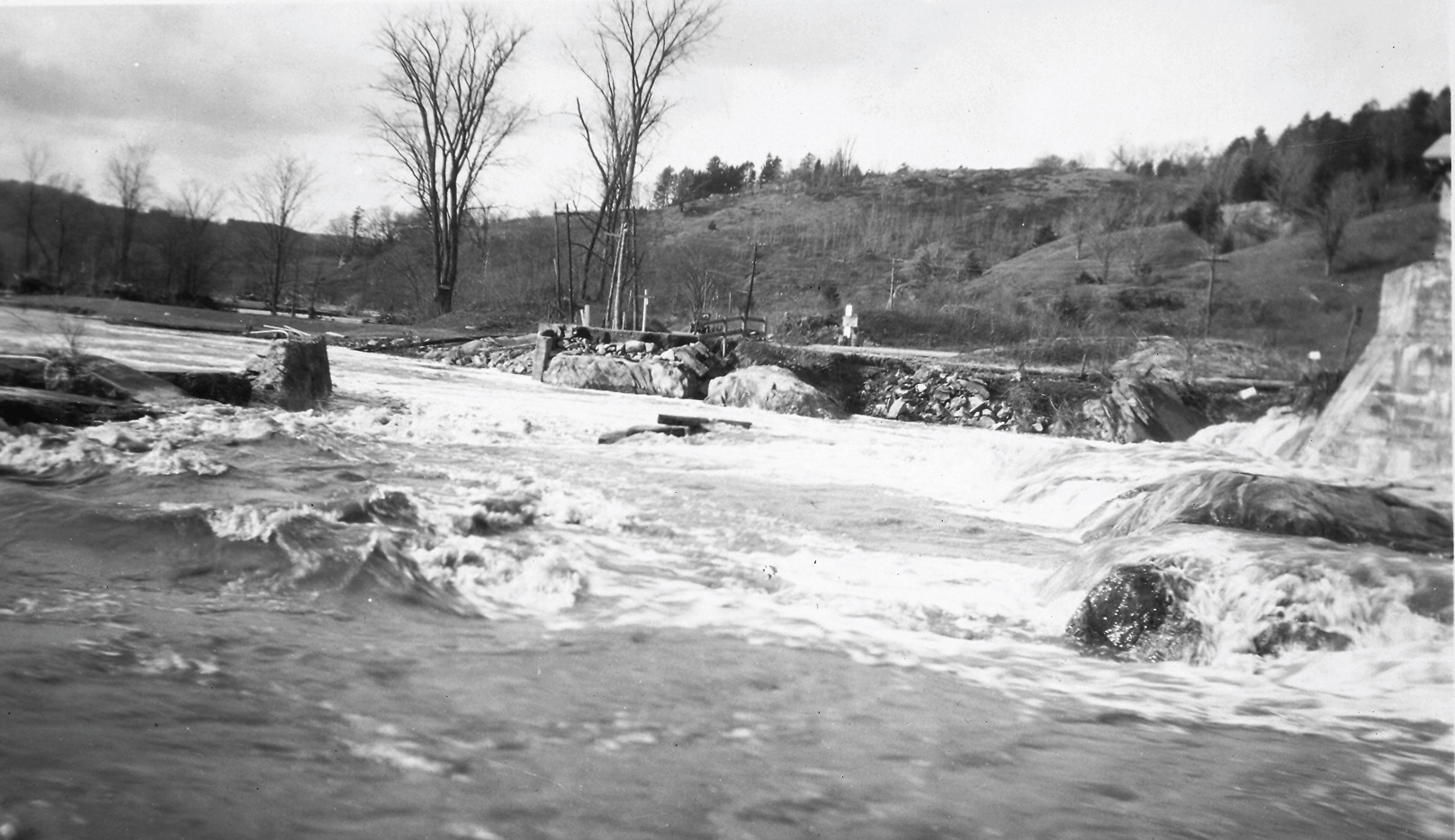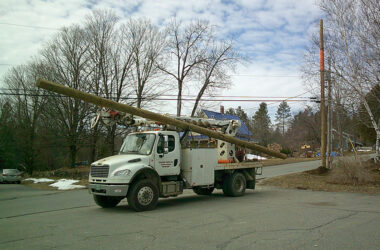
photo courtesy Hardwick Historical Society
In East Hardwick, the mills powered by the river never recovered after the 1927 flood.
[The following is an excerpt from the Summer 2023 edition of The Hardwick Historical Society Journal, reprinted with permission to provide historical perspective on recent events.]
by Elizabeth Dow, Hardwick Historical Society
“Local Lumps,” the weekly column in the Hardwick Gazette that covered personal comings and goings in Hardwick, reported on Thursday, November 3, 1927, that “rain has continued to fall in a down-pour all day today and part of the night, and the Lamoille riover[sic] is at as high a point as at any time this season. Up until today however, during the past week we have experienced the finest of autumn weather.”

photo courtesy Hardwick Historical Society
The 1927 flood’s impact affected railroad service in Hardwick.
Publisher Ed Appolt put out a one-page “EXTRA”2 five days later and summarized what he had learned by that time. He set the scene:
“The peak of the flood came here about nine o’clock Thursday night after the all night and all day rain and buildings began to fall prey to the water elements. Owing to stygian1 darkness caused by the loss of electric lights adding to the desolation, and owing of property had to be carried on by aid of lanterns and flashlights. Communication with the outside towns on telegraph and telephone lines, and by highway and railway were cut off almost completely Thursday night and it was not until Saturday that word came drifting through. All kinds of wild rumors persisted to circulate and add to the horror of the
situation.
“Gradually authentic reports came through and the extent of the damage done became appalling in its truth. The heaviest precipitation of rain started at eleven. This was nothing unusual, and caused no great worry or fear amongst the people as to its dangers, until along about noontime, Thursday, people began to realize that we were getting an extraordinary and exceptionally heavy rainstorm; at five o’clock, when the electric lights suddenly went out the real seriousness of the situation began to make itself manifest.”

photo courtesy Hardwick Historical Society
There used to be a bridge here. Notice the abutment at the end of the road and the Jackson Bridge Dam to the right.
The rain had started at 9 p.m. on Wednesday and lasted until about noon on Friday. To report the local damage, Appolt started at the Hardwick/Greensboro line and followed the river, reporting the damage as it went. He presented a relentless story of railroad washouts, road washouts, landslides, changes in the course of the river, and buildings and bridges washed away. Since so many bridges washed away, he made a point of noting bridges that remained in place.
He noted that the tremendous rush of water over the Jackson Bridge dam undermined the bridge’s supports and the covered Jackson Bridge floated 3,000 feet downriver.
Hardwick had suffered “terrible property loss, the railroads and telephone and telegraph companies are practically out of commission,” but Appolt reported that Hardwick wasn’t “the least bit” hit as hard as other towns. He urged his readers to “unite and cooperate and carry on….”
Hardwickians who were out of town when the storm hit began to return. Sam Daniels, Albert Pearson, and Tommy Fisher walked the forty miles from Williamstown. They arrived on Saturday “after
most harrowing experiences.” Blaine Grow walked from Island Pond, bringing tales that showed that “we here are indeed fortunate.”

The Mackville gulch that resulted from the 1927 flooding in Hardwick.
Bert Hooper and his family came from Montpelier on Sunday with “stories of hardship and suffering that will cause the chills to go chasing up and down your spine.”
“Hardwick girls,” students at Johnson Normal School, walked home, showing “more than ordinary amount of real grit” and bearing “heart-rending” stories.
Large gangs of men were at work everywhere, and, by the time of Appolt’s extra edition, railroad work trains had made their way to Dow’s Crossing in Walden. Appolt urged owners of automobiles to conserve gas for the construction trucks that would need the supply on hand. While the Village Electric Department’s power plant at Wolcott had suffered a lot of damage, the department had connected to the Danville power plant using the wiring to the Woodbury Granite Company quarries in Woodbury.
Appolt included anecdotal information about the state of other towns, then ended the page with a block announcement that “Mail Service Established To-day.” Airplanes would travel between Boston and Montpelier daily. Routes between St. Johnsbury, Barre and Montpelier were in service. He described the route from “St. Johnsbury to […] Walden by train, automobile to Hardwick, thence to Wolcott by gasoline car on the railroad, and thence by automobile to Burlington.”2
1. “Extremely dark, gloomy, and forbidding; related to the River Styx” Merriam Webster Dictionary https:// www.merriam-webster.com/dictionary/stygian (accessed July 15, 2023).
2. “EXTRA,” Hardwick Gazette, November 8, 1927, 1.
[The Hardwick Historical Society Journal goes to the mailbox of every member quarterly. To join, go to hardwickvthistory.org







